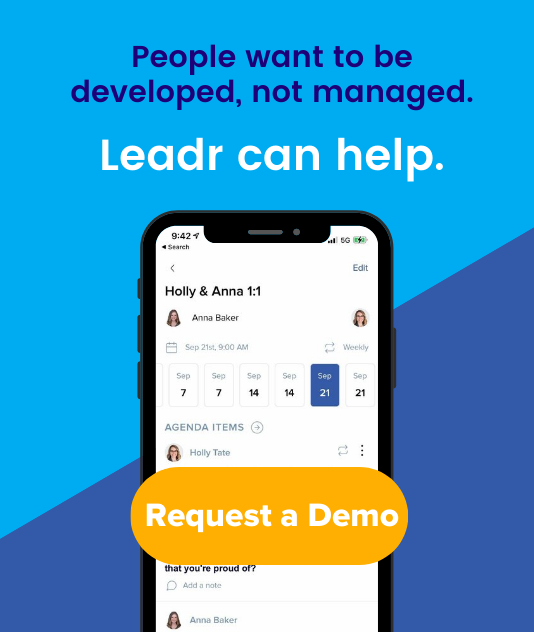4 Practical Tips for More Effective 1:1 Meetings
One-on-one meetings are a manager’s most powerful tool. But to get the full impact, one-on-one’s can’t just be a time for your team members to ask task-based questions and align on the week’s priority list.
The magic happens when you make space to address the development and growth of your team members in these meetings. Investing in your work will make you good, but investing in yourself will make you great. So how do you practically develop your staff through one-on-one meetings? We’re glad you asked!
There is success in the right approach.
If you, as a leader, show up to 1:1’s as the taskmaster, only concerned about what needs to be done, you’re missing out on the unique talents of the person in front of you and what you could be learning about them. The truth is, most of us don’t get consistent interaction with the people we’re leading or the people who are leading us, and when we do it can feel like they only care about what we’re doing or that we’re not important enough for them to actually see us. You should be trying to see the person through the position. You need to know and understand who you’re leading, and you should feel known and understood by who’s leading you.
Here’s an idea. If you believe that every person on your team or in your organization has dignity and value, then you’ll show up to a space differently than if you’re just trying to manage what they’re doing. When you assume that every person has dignity and value, you won’t start from the idea of “what can you produce and how does that benefit me?”
Of course, we all have things we’re accountable for, reasons we were hired, and tasks that need to get done. The real beauty of a 1:1 happens when you understand the importance of those things but, instead of focusing on what someone is doing, you focus on who they’re becoming. It’s the idea of trying to engage an entire person, not just what they’re doing. At the end of the day, investing in people is what leads to growth and success.

The four coaching questions to ask during your 1:1’s:
- Where are you winning?
- What are your challenges?
- What are you doing about it?
- How can I help?
When you ask these questions in your 1:1’s, you’re communicating that “There’s ownership in these four pieces, but I’m here to help support you as you’re leading those things.”
There’s also give and take in all of those questions. You want to be aware of who the person is and what they have going on personally and professionally, and guide them accordingly. If you lead a team of people, you should be leading each person differently because they’re all unique individuals with different needs. As a team, you can have clarity in what your goal is, but the challenging (and fun) part about leading is understanding the individual, what piece they are responsible for, what obstacles are in their way because of who they are, or what role they have, and helping them overcome those so you can arrive where you’re trying to go together.
The “Sacred Space” of leadership.
Pete Scazzero, a pastor, psychotherapist, and author first wrote about Sacred Space. It’s the idea that the sacred space you’re trying to engage is the space in between two people. When two people show up and you’re both fully present, incredible change can happen in that sacred space. When it comes to 1:1’s, whether you’re leading or being led, how can you show up as your healthiest, whole self? Showing up as a whole person, strengths, flaws, interests, frustrations, and all is the best way to show up.
Consistency is key.
1:1’s, when done well and consistently, can help to create that safe, sacred space where you can have real conversations about real life, but also stay accountable to what you’re required to do, and you can do that in a way that is both empowering and challenging.
1:1’s should be the “rule of life” at your organization, but don’t think of that rule as something arbitrary that tells you what you can and can’t do. Rule is actually an old Greek word that means trellis. Think of 1:1’s as your organization's trellis, the thing that provides support for what’s already being cultivated so your organization can be healthy and fruitful.
Here’s what can happen when you practice 1:1’s this way: you can actually unlock each person’s unique capacity and potential. If you take care of your people, the mission will take care of itself.
So, how do you have more effective 1:1 meetings?
Here are three questions to ask week after week in order to help your staff grow:
1. How are you doing personally/holistically - RPMS?
Ask your staff or team how they are doing relationally, physically, mentally, and spiritually, and take note of what they have going on.
2. How are you tracking towards your goals?
This is a time to undo roadblocks. Find out what challenges or fears your team is facing that are getting in the way of their goals.
3. How can I be a better leader to you and the team?
Part of helping your team grow is learning where you need to grow.
Addressing these topics week after week will offer consistency for your team to know when and where they can discuss their development and show them that you are taking practical steps to help them grow.
Where do you need to grow as a leader? Which step do you need to work on? How do you want to be led? We’re curious to know, so don’t forget to share!
Share this
You May Also Like
These Related Stories

Three Steps to More Effective 1:1 Meetings

[2 Min Read] Why 1:1s Are Your Most Important Meeting




No Comments Yet
Let us know what you think